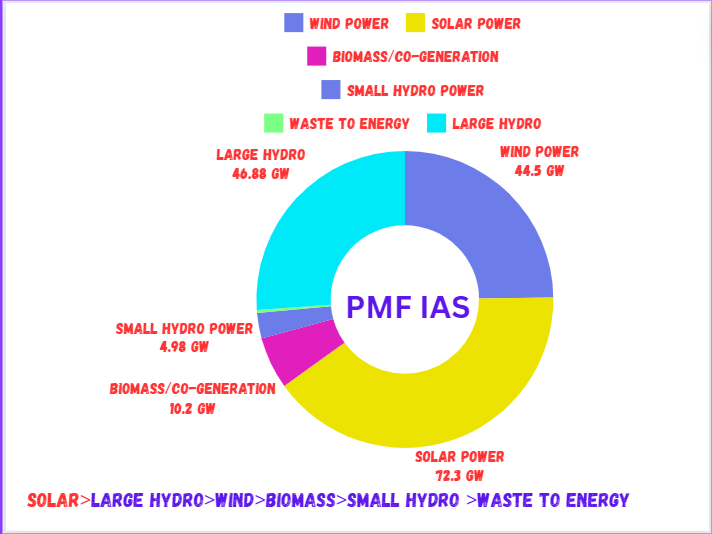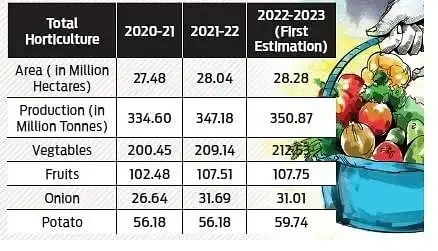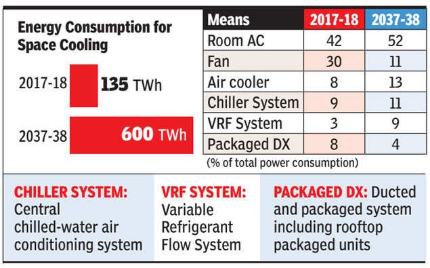
Pradhan Mantri Suryodaya Yojana
Subscribers of "Current Affairs" course can Download Daily Current Affairs in PDF/DOC
Subscribe to Never Miss an Important Update! Assured Discounts on New Products!
Must Join PMF IAS Telegram Channel & PMF IAS History Telegram Channel
- Context (IE): Prime Minister launched the Pradhan Mantri Suryodaya Yojana.
- Under the scheme, one crore households will receive rooftop solar power systems.
- In 2014, the government launched the Rooftop Solar Programme with a goal of 40 GW by 2022. This target was extended to 2026 as it could not be achieved on time.
- The new scheme, Pradhan Mantri Suryodaya Yojana, is an effort to reach the 40 GW rooftop solar capacity goal.
Rooftop Solar Programme
- It was launched in 2014 and aims to increase India’s rooftop solar capacity in residential areas.
- It provides financial assistance and incentives to distribution companies (DISCOMs) and individuals.
- The goal is to achieve 40 GW of rooftop solar capacity by March 2026, currently in its second phase.
- Due to the program, rooftop solar has increased from 1.8 GW (2019) to 10.4 GW (2023).
- Consumers can avail benefits of the scheme through DISCOM tendered projects or the National Portal.
India’s current solar capacity
| Total Solar Capacity (GW) |
Rooftop Solar Capacity (GW) |
|
|
|
|
| India’s current renewable energy capacity stands at around 180 GW. | |
|
Installed capacity for Renewables

India’s Renewable Energy Capacity (2023)
|
Why is an expansion of solar energy important for India?
- Rising Energy Demand: India’s energy supply is set to rise from 42 exajoules (EJ) in 2022 to 53.7 EJ in 2030 and 73 EJ in 2050. (International Energy Agency (IEA) latest World Energy Outlook).
- Diversification of Energy Sources: Dependence on traditional sources like coal is not sustainable in the long term.
- Environmental Benefits: Solar energy is a clean and green source of power, contributing to the reduction of greenhouse gas emissions.
- Self-Reliance in Energy: India already imports around 40% of its primary energy. By expanding its solar capacity, India aims to reduce its reliance on imported fossil fuels.
- Global Commitments: India, at COP26, has pledged to achieve 500 GW of renewable energy by 2030.
|
- Job Creation: As the solar sector expands, it creates jobs in manufacturing, installation, maintenance, and related fields, contributing to economic growth.
- Reduction of Power Deficits: Solar energy projects can be deployed in various regions, including remote and off-grid areas. This helps address power deficits in certain areas.
GoI initiatives for Solar Power
- Production Linked Incentive Scheme (PLI) for National Programme on High-Efficiency Solar PV Modules.
- Solar Park Scheme, designed to establish 50 Solar Parks of 500 MW and above.
- PM-KUSUM aimed to achieve solar power capacity addition of 30.8 GW by March 2026.
- Rooftop Solar Programme for the residential sector.
- Off-grid Solar PV Applications Programme for rural areas.
- International Solar Alliance (ISA).
- Pradhan Mantri Suryodaya Yojana.





![PMF IAS Environment for UPSC 2022-23 [paperback] PMF IAS [Nov 30, 2021]…](https://pmfias.b-cdn.net/wp-content/uploads/2024/04/pmfiasenvironmentforupsc2022-23paperbackpmfiasnov302021.jpg)










